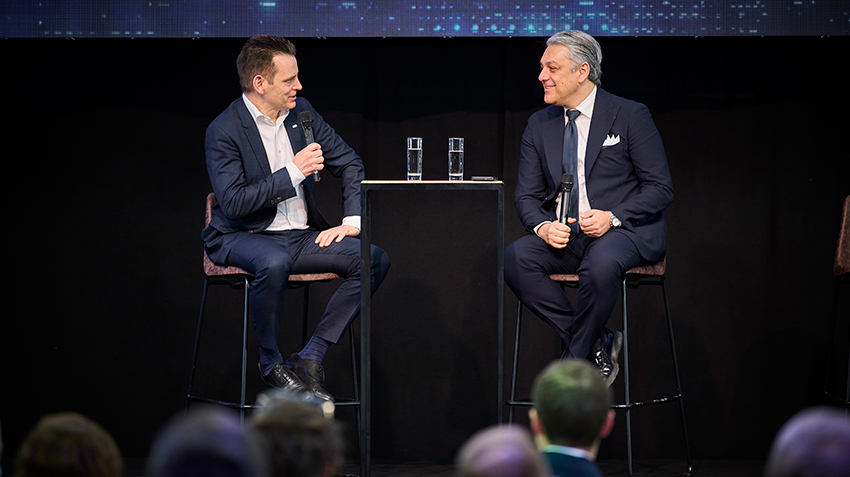Automotive and energy industries join forces to ignite the electric drive in Europe


‘Cars are a work of art. They are a perfect combination of engineering excellence and beauty by human design’
– said Eurelectric’s Secretary General, Kristian Ruby, setting the stage for EVision’s first session. And what better examples of such works of art than electric vehicles (EVs). These technological marvels are slowly but surely taking over the industry, shows Eurelectric-EY latest report, with one in five new cars sold being electric or plug-in hybrids in Europe today.
With close to 60% of global car sales being electric by 2030 according to the International Energy Agency and with 15 countries already moving into mainstream, the evolution is clear to see. Growth is there for all vehicle segments, trucks, buses, vans, the transition is happening but how do we guarantee a future proof success in Europe?
The European landscape is witnessing a rapid uptake in EV adoption, with an anticipated 75 million EVs expected on the roads by 2030. While this may sound promising, it is nevertheless critical to assess the readiness of current and future infrastructure needed to support the EV uptake. Much like the harmony of engineering and design found in cars, the future of EVs relies on a seamless blend of synergies from both the electricity and automotive industries.
"We need to do it together – original equipment manufacturers (OEMs), grid operators, charging points installers – in order to overcome challenges and shape the future of electric mobility" – Ruby continues.
The session set out to explore the roadblocks and catalysts impacting the EV evolution and the ways in which different players can collaborate to face these challenges.
The Power of Unity: cross-sectoral collaboration for mass market EV adoption
Our new study shows that EVs sales will takeover traditional internal combustion engines by 2027 in Europe. Achieving this game-changing goal, however, will require a symphony of efforts, transcending traditional industry needs.
The EV journey is a team sport where different industry players must connect the dots to underscore the challenges and opportunities at the intersection of the automotive and electricity industries.
‘We have similar problems even if on various sides of the fence – we should work more together. Better to partner rather that point fingers at each other’ – states Leonhard Birnbaum.
Luca de Meo, President of ACEA and Renault CEO affirmed in a fireside chat with Leonhard Birnbaum – CEO at E.ON and President of Eurelectric:
‘When EVs become mainstream, we will become an electricity heavy industry. We will need five times more the energy to build an EV than to run it for one year. This is an enormous amount.’
Building giga factories, adding grid capacity and making EV charging interoperable are key enablers of the needed EV rollout. Yet the support on this from Europe is not felt by automakers, creating a real disparity on the global scene.
Today Europe is competing with heavily subsidised Chinese and American markets. Europe is the second largest market for electric vehicles after China, but the US is rapidly picking up.
‘Right now, we are focusing efforts on research and development (R&D) with little investment on capex support and compared to our international competitors, we are falling behind’- adds De Meo.
The infrastructure challenge
Complications in the rollout of EVs are not just the automaker’s challenge. The heavily regulated electric industry also faces complexities. Europe’s electricity infrastructure needs an overhaul. Distribution grids must be rapidly build out and digitalised to accommodate growing future power demand. This requires a capital boost for our networks underpinned by anticipatory investments to bring our infrastructure up to speed with the EV revolution and EU energy transition.
Echoing this call Mark van Stiphout – Deputy Head of Unit, DG ENER said: “There is a realisation that we need to do more – we are putting efforts into it, the European Commission is discussing with regulators to ensure that investment in distribution grids happen.’
Once the infrastructure is in place, success in electrifying the road transport in Europe will ultimately depend on the final EV user.
Putting EV users in the driving seat
“We still have many consumers that are quite hesitant. We need all our customers to feel confident that they have a vehicle that meet all their needs.” - explains CEO for Europe, Hyundai, Michael Cole. The customer experience will be an important facet for all to consider and collaboration between players on this will be crucial to the success of the rollout.
Data Interoperability can play a critical role in making the EV experience as smooth as possible. We know that this ecosystem will be fully digital – even more digitalised than other sectors since EVs are computers on wheels. If we are to maintain momentum, and keep EV drivers enthusiasm high, every interaction must be configured for a seamless customer experience.
From purchase or lease, through EV usage and management, to end-of-life decommissioning, we must deliver a hassle-free and green driver experience. This can only happen if data becomes interoperable across the value chain through standardised protocols, charging roaming networks, grid congestion heat maps and common platforms to break down data silos.
Charting the Course Ahead
Collaboration between all relevant parties in Europe will be the key to the success of an effective EV takeover. Overlapping all the roadmaps of the industries involved – from the chemical industry to car manufacturers, utilities, and infrastructure operators – together and seeing if a pattern can be seen is, and will be, paramount. We must foster an environment where stakeholders collaborate rather than compete.
‘’Let’s do this and let’s do it right. And let’s do it our way. Not the Chinese command and control. Not the American winner takes all. The European way.’’ – Kristian Ruby
